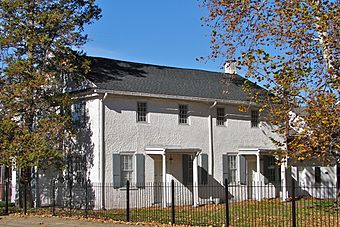Bristol Historic District facts for kids
Quick facts for kids |
|
|
Bristol Historic District
|
|

Bristol Friends Meetinghouse
|
|
| Location | Roughly bounded by Pond, Cedar, E. Lincoln Sts., the Delaware River, and E. Mill St., Bristol, Pennsylvania |
|---|---|
| Area | 28 acres (11 ha) |
| Architect | Sloan, Samuel; et al. |
| Architectural style | Mid 19th Century Revival, Late Victorian, Federal |
| NRHP reference No. | 87000665 |
| Added to NRHP | April 30, 1987 |
The Bristol Historic District is a special area in Bristol, Pennsylvania. It was added to the National Register of Historic Places in 1987. This means it's recognized as an important historical place.
The district has over 300 buildings. Some of these buildings are very old, dating back to the early 1700s! It covers 28 acres, which is about the size of the original town when it was first planned in 1697. The district is bordered by the Delaware River and several streets: Lincoln, Pond, Cedar, and Mill Streets. Most of the buildings here are homes. Only a few buildings are considered "non-historic," meaning they don't quite fit the old style of the area.
Contents
History of Bristol's Historic District
Bristol has a long and interesting past. It played an important role in the early days of Pennsylvania.
Bristol's Early Days
The first European settler in Bristol was Samuel Clift. He started a ferry service across the Delaware River in 1681. Soon, a Quaker community grew around his ferry.
In 1697, the people living there asked the government to make their community an official town. It became the third town in the Pennsylvania Colony. The Bristol Friends Meetinghouse, built between 1711 and 1714, is still standing today. It shows what the town looked like in those early years. Many other buildings were lost in a big fire in 1724.
Growth in the 1700s
During the late 1700s, Bristol became an important stop. It was on the stagecoach route between New York and Philadelphia. The Delaware Hotel, located at Radcliffe and Mill Street, was first built in 1765. It has been changed and added to many times since then.
The Thomas Belford residence at 200 Mill Street was built in 1781. It later became a drug store. From the 1780s to the 1820s, a place called Bath Springs became famous. It was just north of the original town and was a popular spa. Wealthy people from Philadelphia and New York built large homes there. Shipbuilding was also a very important business in Bristol during this time.
The Canal Era and New Buildings
In 1832, the Delaware Division of the Pennsylvania Canal was finished. Bristol was at its southern end, making the town a major transportation center. Businesses boomed! Hotels, wharves (docks), and warehouses lined the riverfront.
Around 1855, this boom slowed down. The canal gained a new connection to the Delaware River further north. This allowed boats to go to New York without passing through Bristol. Many of the houses on the 300 block of Radcliffe Street were built during this busy period. The First Baptist Church, built in 1851, was designed by Thomas U. Walter. St. James Episcopal Church, designed by Samuel Sloan, was finished in 1857. The beautiful Dorrance Mansion was completed during the time of the Civil War.
Bristol After the Civil War
After the Civil War, Bristol's economy got better. New mills and factories were built along the canal. The canal provided both water power and a way to transport goods. Bristol became the biggest industrial center in Bucks County. The town grew with new homes for workers and grand mansions for the factory owners.
Gallery
-
Riverfront of the Dorrance Mansion








